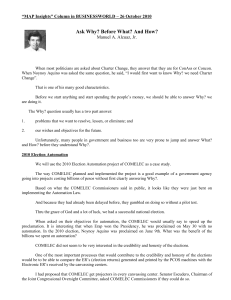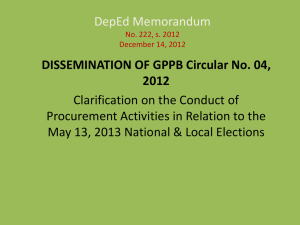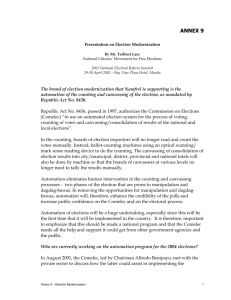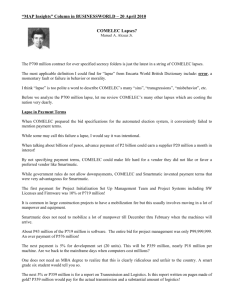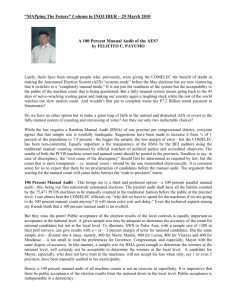Automated poll system
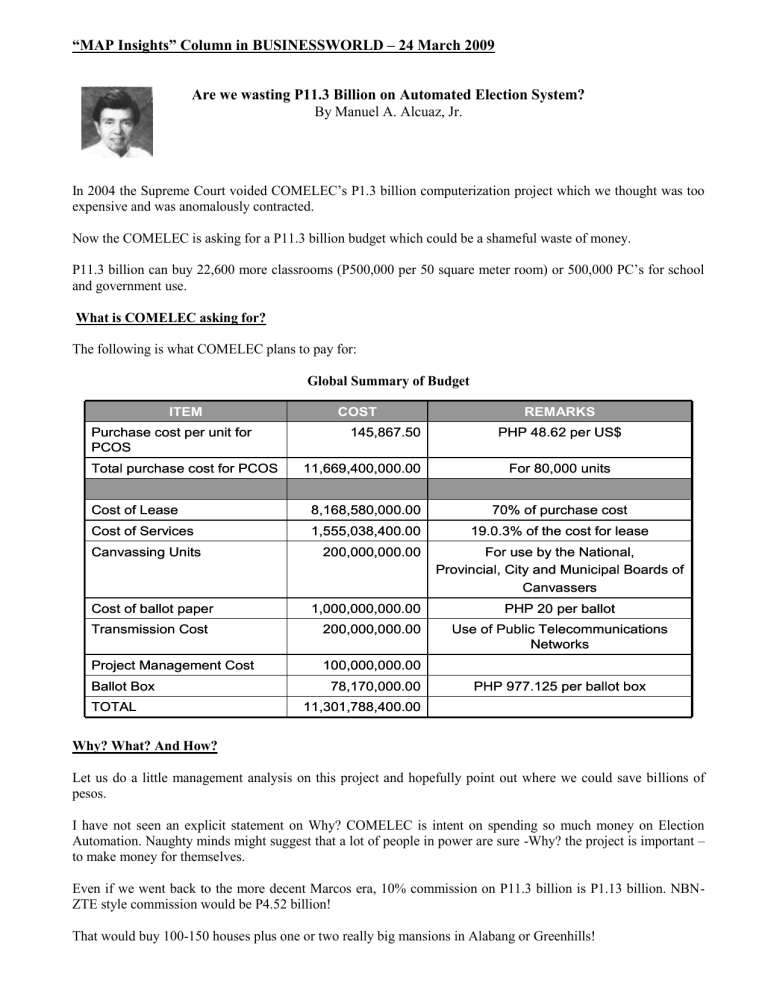
“MAP Insights” Column in BUSINESSWORLD – 24 March 2009
Are we wasting P11.3 Billion on Automated Election System?
By Manuel A. Alcuaz, Jr.
In 2004 the Supreme Court voided COMELEC’s P1.3 billion computerization project which we thought was too expensive and was anomalously contracted.
Now the COMELEC is asking for a P11.3 billion budget which could be a shameful waste of money.
P11.3 billion can buy 22,600 more classrooms (P500,000 per 50 square meter room) or 500,000 PC’s for school and government use.
What is COMELEC asking for?
The following is what COMELEC plans to pay for:
Global Summary of Budget
Why? What? And How?
Let us do a little management analysis on this project and hopefully point out where we could save billions of pesos.
I have not seen an explicit statement on Why? COMELEC is intent on spending so much money on Election
Automation. Naughty minds might suggest that a lot of people in power are sure -Why? the project is important – to make money for themselves.
Even if we went back to the more decent Marcos era, 10% commission on P11.3 billion is P1.13 billion. NBN-
ZTE style commission would be P4.52 billion!
That would buy 100-150 houses plus one or two really big mansions in Alabang or Greenhills!
In business and management we start by asking Why? something should be done.
I have heard and can think of a number of reasons for automating the election system:
Quicker election results
Less cheating
Transparency and Credibility
We will tackle each reason one by one.
Quicker Election Results
The election counting process is made up of three primary activities:
1.
counting by precinct
2.
transmission or transportation
3.
canvassing or consolidation
There are three levels of canvassing or consolidation:
1.
municipal/ city
2.
provincial
3.
national
In past elections national results have taken weeks to be completed.
The long delays are primarily due to delays in transmission and canvassing. And the delays in canvassing are generally due to lawyers raising a lot of issues not due to the time it takes to add the votes in election returns or statement of votes.
The counting in the precincts is generally finished in three to six hours, lets say half a day. If it takes 25 to 40 days to complete the national election results, the manual counting in the precincts contributes to less than 1.25 to 2% of the elapsed time.
The COMELEC is budgeting P 8,168,580 (72.3%) for the lease of 80,000 PCOS (Optical Mark Counting
Machines). It plans to deploy one machine per cluster of 5 precincts.
On the other hand it budgeted P200 million for canvassing units and another P200 million for transmission cost.
Only 3.5% of the budget is allocated to the activities that take up 98% of the national election counting and canvassing process! Obviously a misallocation of resources.
In addition there is a budget of P1,555,038,400 for services more than 95% of this cost is for the warehousing, deployment, and technical support of the PCOS (OMR counting machines).
It should be noted that unlike other proposals where the equipment is bought, COMELEC’s proposal is for lease of the equipment. This means that practically all the P8 million plus will be leave the country and have no value for the Philippines. With the exception of some of the commissions which might come back to the country.
And the COMELEC is willing to pay 70% of the cost of the machines for use in one election! Why not buy used machines at 30%?
Less Cheating
Cheating in elections is typically divided into:
retail cheating
wholesale cheating
Retail cheating includes:
vote buying
substitution of ballots
misreading and mistallying of ballots
While wholesale cheating includes:
changing or substitution of election returns
dagdag bawas in consolidation of election returns
change or substitution of municipal COC’s (Certificate of Canvass)
dagdag bawas in consolidating municipal COC’s
changing or substitution of provincial COC’s
dagdag bawas in consolidating provincial and city statement of votes into national total.
Prior to the 2007 elections it seemed that vote buying had lessened dramatically. Since those who wished to cheat saw wholesale cheating to be m ore cost-effective.
In 2007 there was an apparent increase in vote buying because of the provisions of RA 9369 for the posting of election returns and certificates of canvass. And explicit permission given to private citizens to do their own tabulations.
Will OMR Counting Machines Reduce Retail Cheating
The nearly P9.5 billion budgeted for OMR counting machines and their support will have very little effect on wholesale cheating. Its value would primarily be on retail cheating.
Automation would have no influence on vote buying.
The manufacturing of fraudulent ballots would be much easier since those cheating would only have to mark circles instead of writing the name of each candidate to be voted. One cheating clerk could produce take votes about 5 to 10 times faster.
OMR voting has an extra bonus for cheaters. In case a protest or recount it will be very hard to show that a few persons filled up many ballots.
This is a minus for OMR voting and counting.
In the traditional manual voting there are instances of misreading and mistallying of votes during the counting.
However, this is normally lessened by the fact that three people read the votes and watchers can see the tallying.
Significant cheating in counting happens only when a precinct is controlled by money, guns, or goons.
An OMR counting machine would under normal circumstances be accurate in counting.
However, how can citizens feel confident that the machines are counting properly?
The COMELEC has not instituted procedures for auditing the machines.
The COMELEC takes pride in two innovations:
1.
the voter feeds the ballot into the OMR counting machine
2.
the machine takes a picture of the ballot.
In a precinct controlled by money, guns, or goons citizens may exchange their blank ballot with a prefilled ballot.
When he feeds the prefilled ballot into the machine its not his vote that is counted.
His ballot can be filled by someone and given to the next cooperating voter.
It should be remembered that each machine is being shared by 5 precincts. Poll watching may be hampered.
The picture taking innovation has no value in lessening cheating.
It merely increases the cost of the machines and may be introduced to eliminate OMR reading vendors whose machines don’t take pictures.
Electronic Transmission and Canvassing
The COMELEC AES provides for electronic transmission of ER’s (electronic returns) from OMR counting machine to municipal automated canvassing/consolidation centers.
It also provides for posting of results to the COMELEC website.
If we could absolutely trust COMELEC and its vendors, then this would be fine.
However, the entire system lacks transparency, independent checking and auditing. As well as fail safe back-up..
The COMELEC AES presentation says’
At Close of Polls
automatic counting
-
printing of 5 copies of election returns electronic transmission of precinct results
printing of 22 copies of election returns
all copies signed by BEI Chairman
RA 9369 Sec.22 provides for each copy of ER is signed and thumbmarked by all members of the BEI and watchers present. COMELEC seems to have changed this provision.
How can the nation be assured that an electronic version of Garcilliano is not busy at work, and that we will not see a repeat of how FPJ was cheated in 2004 or how Pimentel lost his senate bid as a result of Maguindanao in
2007?
In the manual system we are used to, the election returns and ballot boxes are brought to the municipal canvassing center by the BEI accompanied by watchers of political parties and citizens group.
When the election returns are read and canvassed, these is done in a transparent manner with hundreds of watchers.
The election returns can be physically examined for authenticity and for erasures. Lawyers of the parties and candidates can raise objections.
This is what delays the canvassing process. It is also what helps minimize cheating in most of the country. With the exception of ARMM and Pampanga,Cebu, Bohol, and Iloilo in 2004 and Maguindanao in 2007.
With the proposed electronic transmission, how do we make sure that the election returns from the OMR counting machines are not changed to favor some candidates?
When the returns are received in the municipal consolidation server, how can we be sure that what was received is not changed prior to canvass/consolidation?
The same questions can be raised about transmission from electronic COC from the municipality to the province canvassing server, or the provincial COC to the national senatorial and presidential canvassing servers.
The COMELEC presentation does not discuss transparency and auditability.
COMELEC claims that national result will be known in 3 or 4 days.
I would rather wait the usual 25 to 40 days but have the assurance that we will know that we were not cheated or at least know that we were cheated.
In the new system we will be told the results in 3 to 4 days. But we will not know if there was cheating and manipulation,
In COMELEC we trust!?
Don’t. We will suffer a double whammy! More than P10 billion will be wasted and rampant electronic dagdag bawas may take place.
(The article reflects the personal opinion of the author and does not reflect the official stand of the Management
Association of the Philippines. The author is President of Systems Sciences Consult, Inc. Feedback at map@globelines.com.ph. For previous articles, please visit <map.org.ph>.)
G:\map insights\2009\malcuaz - 24March2009.doc::mel
